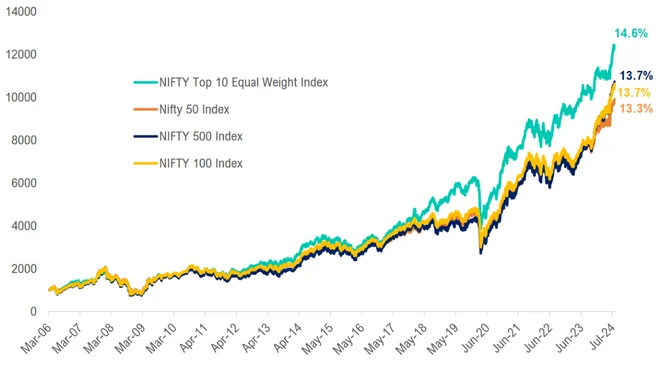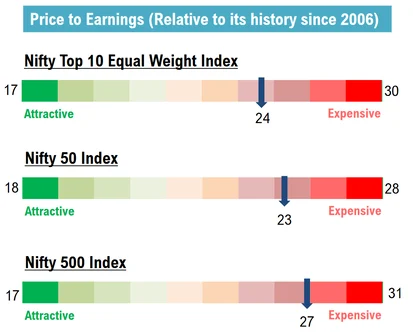Summary
The Nifty Top 10 Equal Weight Index (Nifty 10) offers several advantages, including superior long-term performance, consistent returns, and attractive valuation metrics compared to broader indices. It may outperform during market polarizations, has lower drawdowns despite higher volatility, and mirrors the success of top indices like the S&P 500 Top 10.
In the Indian equities market, the 100 biggest stocks by market cap are considered to be large-caps.
Now, you might wonder: would the benefits of large-caps get amplified if you distilled them to create an index comprising only the 10 biggest stocks?
There’s a good chance that the answer is ‘yes’. In this post, we’ll present ten reasons why a fund tracking such an index, namely the Nifty Top 10 Equal Weight Index (henceforth, ‘the Nifty 10 index’), might be a good pick for investors.
A quick aside: the Nifty 10 index is 'equal-weighted', which means that every constituent stock's performance has an equal impact on the index value. This is in contrast to a market-cap-weighted index, where a constituent stock with a bigger market cap can move the index more easily compared to a constituent stock with a smaller market cap.
1. Superior long-term performance
The Nifty 10 index has posted a better CAGR than broader market indices over the last 18-odd years.

Source – NSE, Internal. Data as of July 2024.*
2. Consistency across investment horizons
The median rolling returns (i.e. the most likely returns over a given horizon) of the Nifty 10 index are better than those of broader market indices over horizons of 1, 3, 5, and 10 years.

Source – Bloomberg, NSE, Internal. Data as of July 2024.*
3. Relative outperformance on the way?
The chart below indicates the 3-year rolling alpha (i.e. outperformance) of the Nifty 10 index relative to the Nifty 50 index.
What’s important to note here is that so far, whenever the 3-year historical alpha has been negative, the forward 3-year alpha has always been positive. Thus, since the current 3-year historical alpha is negative, there’s a good chance that it might turn around in the near future.

Source – Bloomberg, NSE, Internal. Data as of July 2024.*
4. Favourable market cycles
The chart below indicates the proportion of the top 10 stocks’ market cap with respect to the total market cap of all listed stocks. As can be seen, the share of the top 10 stocks is currently at an all-time low. This has happened due to ‘depolarisation’, i.e. a broad-based rally in stocks.
However, in the event of a ‘polarisation’, i.e. a rally involving only the top 10 stocks, the Nifty 10 index will outperform the broader market.
Polarisation and depolarisation are cyclical phenomena, as can be seen from the chart. Given that there has been significant depolarisation over the last four years, a polarisation might be due; this would then bolster the Nifty 10 index.

Source – Bloomberg, NSE, Internal. Data as of July 2024.*
5. Lower drawdowns despite higher volatility
Despite having a slightly greater volatility due to its concentrated portfolio, the Nifty 10 index still posts annual drawdowns that are usually lower than those of broader market indices, as can be seen in the table below.

Source – NSE, Internal. Data as of July 2024.*
6. Attractive price to earnings (P/E) ratio
The P/E ratio is a metric used to determine whether a stock or index is overpriced or underpriced. As can be seen below, the Nifty 10 index has a more attractive P/E ratio compared to broader market indices relative to its history.

Source – NSE, Internal. Data as of July 2024. The arrow represents current positioning in terms of percentile since Apr 2006. Top 10% & Bottom 10% of the valuation data points have been excluded to remove the effect of extreme data points.*
7. Attractive price to book (P/B) ratio
The P/B ratio is yet another metric used to determine whether or not a stock or index is expensive. In this regard as well, the Nifty 10 index fares better than broader market indices.

Source – NSE, Internal. Data as of July 2024. The arrow represents current positioning in terms of percentile since Apr 2006. Top 10% & Bottom 10% of the valuation data points have been excluded to remove the effect of extreme data points.*
8. Good value relative to market
We could also divide the Nifty 10 index’s P/E ratio by the Nifty 50 index’s P/E ratio to compare their relative valuations. As the graph below indicates, the Nifty 10 index is currently in a favourable zone in terms of its relative valuation. This is also true if the Nifty 10 index’s P/E ratio is compared with the Nifty 500 index’ P/E ratio.

Source – NSE, Internal. Data as of July 2024.*
9. Strong RoE and RoA
The Nifty 10 index has delivered significantly higher Return on Equity and Return on Assets (RoE and RoA respectively: two important measures of a company’s financial performance) compared to broader indices.

Source – Bloomberg, Internal. Data as of July 2024.*

Source – Bloomberg, Internal. Data as of July 2024.*
10. Learning from international markets: a US comparison
Lastly, if we were to look at the equivalent of the Nifty 10 index for the US equities market, i.e. the ‘S&P 500 Top 10 Index’, we would find that this index has outperformed the broader US market (as represented by the S&P 500 Index) over the last 19-odd years.

Source – NSE, Internal. Data as of July 2024.*
Time for the biggies to shine?
As discussed above, the very biggest Indian stocks might potentially represent an opportunity right now, and it might be a good idea to take a position in them while they're still relatively undervalued as a group.
Speak with our experts to get personalised advice and take the next step in your investment journey.
*These figures pertain to performance of the index and do not in any manner indicate the returns/performance of this scheme.
Industry insights you wouldn't want to miss out on.
Disclaimer
This blog is for information purposes only. The recipient of this material should consult an investment /tax advisor before making an investment decision. In this material DSP Asset Managers Pvt. Ltd. (the AMC) has used information that is publicly available, including information developed in-house and is believed to be from reliable sources. The AMC nor any person connected does not warrant the completeness or accuracy of the information and disclaims all liabilities, losses and damages arising out of the use of this information. Data provided is as of July 2024 (unless otherwise specified) and are subject to change without notice. Past performance may or may not be sustained in the future and should not be used as a basis for comparison with other investments. These figures pertain to performance of the index/Model and do not in any manner indicate the returns/performance of this scheme.
The statements contained herein may include statements of future expectations and other forward-looking statements that are based on prevailing market conditions / various other factors and involve known and unknown risks and uncertainties that could cause actual results, performance or events to differ materially from those expressed or implied in such statements.
All content on this blog is the intellectual property of DSPAMC. The User of this Site may download materials, data etc. displayed on the Site for non-commercial or personal use only. Usage of or reference to the content of this page requires proper credit and citation, including linking back to the original post. Unauthorized copying or reproducing content without attribution may result in legal action.. The User undertakes to comply and be bound by all applicable laws and statutory requirements in India.
For Index disclaimers click here. Large-caps are defined as top 100 stocks on market capitalization, mid-caps as 101-250, small-caps as 251 and above.
Mutual Fund investments are subject to market risks, read all scheme related documents carefully.
 Account Statement
Account Statement  Capital Gain Statement
Capital Gain Statement  Key Information Memorandum
Key Information Memorandum  PAN Updation
PAN Updation  Register / Modify KYC Online
Register / Modify KYC Online  Nominee Registration
Nominee Registration  Email / Phone Updation
Email / Phone Updation  OTM / eNACH Registration
OTM / eNACH Registration  Guidelines for Incapacitated Investors
Guidelines for Incapacitated Investors  FAQs
FAQs Reach us
Reach us















Write a comment